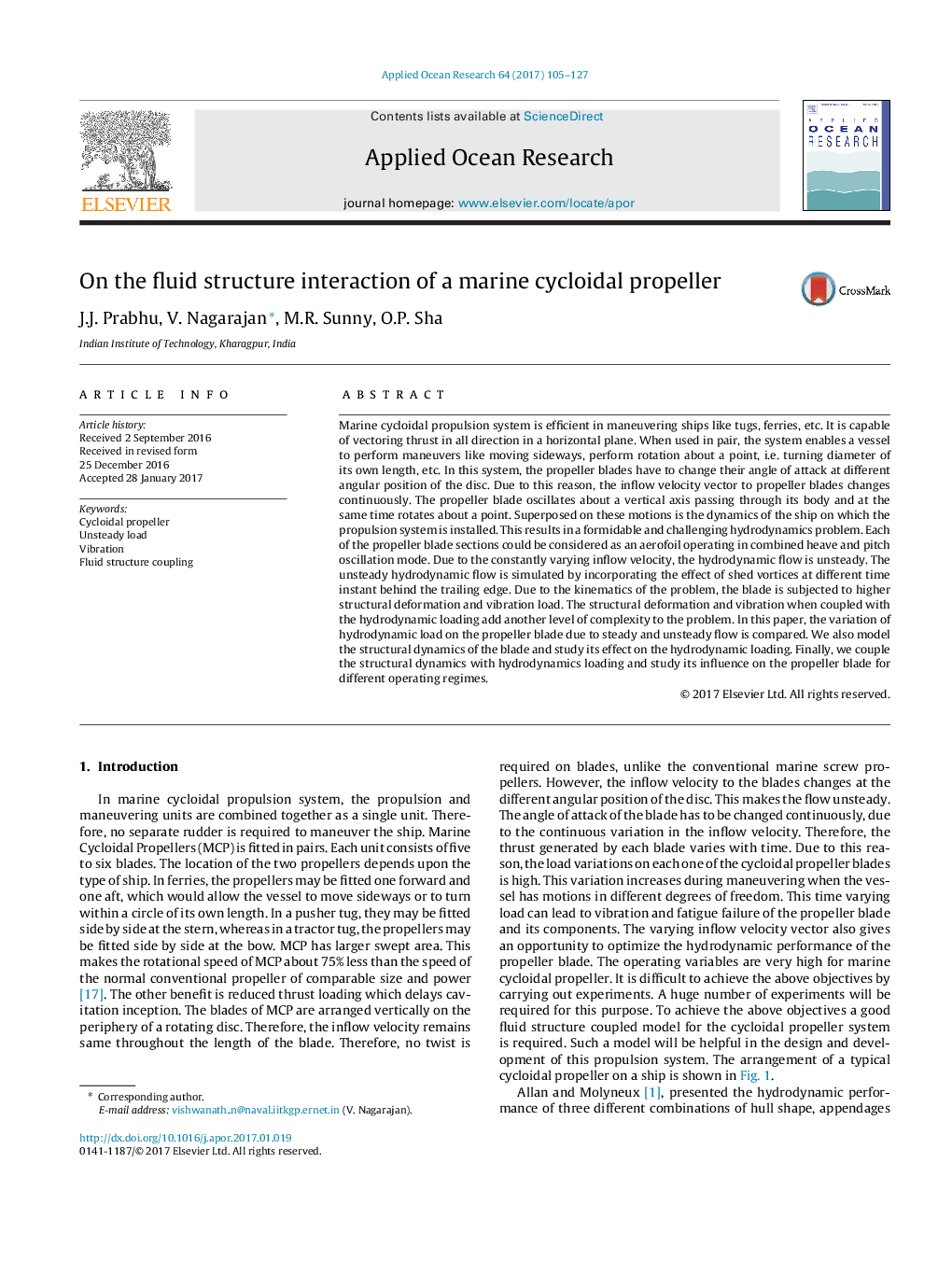| کد مقاله | کد نشریه | سال انتشار | مقاله انگلیسی | نسخه تمام متن |
|---|---|---|---|---|
| 5473186 | 1520239 | 2017 | 23 صفحه PDF | دانلود رایگان |
عنوان انگلیسی مقاله ISI
On the fluid structure interaction of a marine cycloidal propeller
ترجمه فارسی عنوان
بر روی ساختار سیال تعامل یک پروانه ی دریایی سیکلوئید
دانلود مقاله + سفارش ترجمه
دانلود مقاله ISI انگلیسی
رایگان برای ایرانیان
کلمات کلیدی
ترجمه چکیده
سیستم نیروی دریایی سیکلوئید در کشتی های مانور مانند تانک ها، کشتی ها و غیره کارآیی دارد. این توانایی در هر جهت در یک صفحه افقی را دارد. هنگامی که در جفت استفاده می شود، سیستم یک کشتی را قادر می سازد تا مانور هایی مانند حرکت به سمت چپ، انجام چرخش در مورد یک نقطه، یعنی چرخاندن قطر طول خود را، و غیره. در این سیستم، تیغه پروانه باید زاویه حمله خود را در زاویه های مختلف موقعیت دیسک. به همین دلیل، بردار سرعت جریان ورودی به پره های پروانه به طور مداوم تغییر می کند. تیغه پروانه در مورد یک محور عمودی که از بدن آن عبور می کند نوسان می کند و در همان زمان حدود یک نقطه چرخش می کند. در این حرکات قرار داده شده است پویایی کشتی که در آن سیستم نیروی محرکه نصب شده است. این نتیجه یک مشکل هیدرودینامیکی شدید و چالش برانگیز است. هر یک از بخش های تیغه پروانه ای را می توان به عنوان یک هواپیما در حالت ترکیبی و نوسان در نظر گرفت. جریان هیدرودینامیکی به علت سرعت جریان به طور مداوم متغیر است. جریان هیدرودینامیکی غیرمتعارف با ترکیب تأثیر ویروس های ریخته شده در فواصل زمانی مختلف در پشت لبه عقب شبیه سازی شده است. با توجه به سینماتیک مشکل، تیغه تحت تاثیر تغییر شکل ساختاری و بار ارتعاش قرار می گیرد. تغییر شکل ساختاری و ارتعاش در هنگام بارگیری هیدرودینامیک، سطح دیگری از پیچیدگی را به مشکل می دهد. در این مقاله، تغییر بار هیدرودینامیک بر روی تیغه پروانه به دلیل جریان ثابت و غیرمتمرکز مقایسه شده است. ما همچنین دینامیک ساختاری تیغه را مدلسازی کرده و اثر آن را بر بارگذاری هیدرودینامیکی بررسی می کنیم. در نهایت، ما پویایی ساختاری را با بارگذاری هیدرودینامیک جفت می کنیم و اثر آن را روی تیغه پروانه ای برای رژیم های مختلف عملیاتی بررسی می کنیم.
موضوعات مرتبط
مهندسی و علوم پایه
سایر رشته های مهندسی
مهندسی دریا (اقیانوس)
چکیده انگلیسی
Marine cycloidal propulsion system is efficient in maneuvering ships like tugs, ferries, etc. It is capable of vectoring thrust in all direction in a horizontal plane. When used in pair, the system enables a vessel to perform maneuvers like moving sideways, perform rotation about a point, i.e. turning diameter of its own length, etc. In this system, the propeller blades have to change their angle of attack at different angular position of the disc. Due to this reason, the inflow velocity vector to propeller blades changes continuously. The propeller blade oscillates about a vertical axis passing through its body and at the same time rotates about a point. Superposed on these motions is the dynamics of the ship on which the propulsion system is installed. This results in a formidable and challenging hydrodynamics problem. Each of the propeller blade sections could be considered as an aerofoil operating in combined heave and pitch oscillation mode. Due to the constantly varying inflow velocity, the hydrodynamic flow is unsteady. The unsteady hydrodynamic flow is simulated by incorporating the effect of shed vortices at different time instant behind the trailing edge. Due to the kinematics of the problem, the blade is subjected to higher structural deformation and vibration load. The structural deformation and vibration when coupled with the hydrodynamic loading add another level of complexity to the problem. In this paper, the variation of hydrodynamic load on the propeller blade due to steady and unsteady flow is compared. We also model the structural dynamics of the blade and study its effect on the hydrodynamic loading. Finally, we couple the structural dynamics with hydrodynamics loading and study its influence on the propeller blade for different operating regimes.
ناشر
Database: Elsevier - ScienceDirect (ساینس دایرکت)
Journal: Applied Ocean Research - Volume 64, March 2017, Pages 105-127
Journal: Applied Ocean Research - Volume 64, March 2017, Pages 105-127
نویسندگان
J.J. Prabhu, V. Nagarajan, M.R. Sunny, O.P. Sha,
